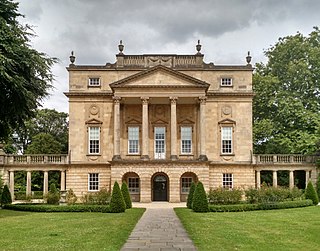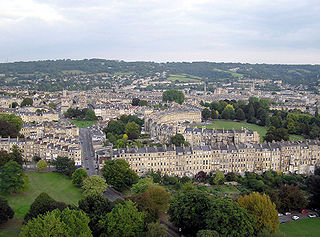
Bathwick is an electoral ward in the City of Bath, England, on the opposite bank of the River Avon to the historic city centre.
John Pinch was an architect working mainly in the city of Bath, England. He was surveyor to the Pulteney and Darlington estate and responsible for many of the later Georgian buildings in Bath, especially in Bathwick.

Great Pulteney Street is a grand thoroughfare that connects Bathwick on the east of the River Avon with the City of Bath, England via the Robert Adam designed Pulteney Bridge. Viewed from the city side of the bridge the road leads directly to the Holburne Museum of Art that was originally the Sydney Hotel where tea rooms, card rooms, a concert room and a ballroom were installed for the amusement of Bath's many visitors.
Thomas Baldwin was an English architect in the city of Bath, who was responsible for designing some of Bath's principal Georgian buildings.

The Holburne Museum is located in Sydney Pleasure Gardens, Bath, Somerset, England. The city's first public art gallery, the Grade I listed building, is home to fine and decorative arts built around the collection of Sir William Holburne. Artists in the collection include Gainsborough, Guardi, Stubbs, Ramsay and Zoffany.

Gay Street in Bath, Somerset, England, links Queen Square to The Circus. It was designed by John Wood, the Elder in 1735 and completed by his son John Wood, the Younger. The land was leased to the elder Wood by Robert Gay, MP for Bath, and the street is named after him. Much of the road has been designated as Grade I listed buildings.

North Parade in Bath, Somerset, England is a historic terrace built around 1741 by John Wood, the Elder. Several of the houses have been designated as Grade I listed buildings.

South Parade in Bath, Somerset, England is a historic terrace built around 1743 by John Wood, the Elder. All of the houses have been designated as Grade I listed buildings.

The Paragon in the Walcot area of Bath, Somerset, England is a street of Georgian houses which have been designated as listed buildings. It was designed by Thomas Warr Attwood. It now forms part of the A4.

Portland Place in Bath, Somerset, England was built around 1786 and many of the houses have been designated as listed buildings.

Bathwick Hill in Bath, Somerset, England is a street lined with historic houses, many of which are designated as listed buildings. It climbs south east from the A36 towards the University of Bath on Claverton Down, providing views over the city.

Henrietta Street in the Bathwick area of Bath, Somerset, England was built around 1785 by Thomas Baldwin.

Johnstone Street in the Bathwick area of Bath, Somerset, England was designed in 1788 by Thomas Baldwin, with some of the buildings being completed around 1805-1810 by John Pinch the elder.

Sion Hill Place in the Lansdown area of Bath, Somerset, England was designed by John Pinch the elder and built between 1818 and 1820. Suspension bridge builder and brewer James Dredge, Sr. lived here in the mid 19th century.

Trim Street in Bath, Somerset, England is an historic street, built in 1707, of shops and houses, many of which are listed buildings. It was named after George Trim who owned the land.

Upper Borough Walls is a historic street in Bath, Somerset, England. Many of the structures are listed buildings.

The buildings and architecture of Bath, a city in Somerset in the south west of England, reveal significant examples of the architecture of England, from the Roman Baths, to the present day. The city became a World Heritage Site in 1987, largely because of its architectural history and the way in which the city landscape draws together public and private buildings and spaces. The many examples of Palladian architecture are purposefully integrated with the urban spaces to provide "picturesque aestheticism". In 2021, the city was added to a second World Heritage Site, a group of historic spa towns across Europe known as the "Great Spas of Europe". Bath is the only entire city in Britain to achieve World Heritage status, and is a popular tourist destination.

Cavendish Crescent in Bath, Somerset, is a Georgian crescent built in the early 19th century to a design by the architect John Pinch the elder. At 11 houses, it is the shortest of the seven Georgian crescents in Bath. It also has one of the plainest facades, with no central feature, the only decoration being the consoles over the central first floor window of each house.
John Pinch (1796–1849) was an architect, working mainly in the city of Bath, England, and surveyor to the Pulteney and Darlington estate. He was the son of John Pinch the elder, also an architect and surveyor to the estate.

Sydney Gardens is a public open space at the end of Great Pulteney Street in Bath, Somerset, England. The gardens are the only remaining eighteenth-century pleasure gardens in the country. They are Grade II listed on the Register of Historic Parks and Gardens of special historic interest in England.


















